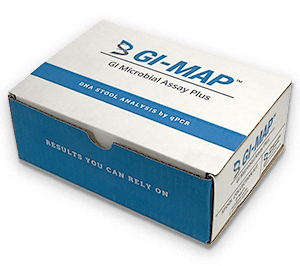

GI-MAP – GI Microbial Assay Plus
The GI-MAP® (Microbial Assay Plus) is a comprehensive stool test that relies on quantitative polymerase chain reaction (qPCR) technology to detect parasites, bacteria, H. pylori, fungi, and more by targeting the specific DNA of the organisms tested.
New for 2025 – Bile Acids and Short Chain Fatty Acids Testing
Introducing the StoolOMX™ Add‑on Panel for GI‑MAP – The new StoolOMX add-on measures 25 bile acids as well as 9 short chain and branch chain fatty acids (SCFAs) — microbial metabolites essential for gut health. SCFAs reflect microbial activity, fiber fermentation, and gut barrier integrity, while bile acid levels provide insights into malabsorption, bile acid diarrhea, and dysbiosis.
 Additionally, recent studies show that up to 30% of patients with IBS‑D are affected by bile acid diarrhea, underscoring the importance of evaluating bile acids in clinical practice.
Additionally, recent studies show that up to 30% of patients with IBS‑D are affected by bile acid diarrhea, underscoring the importance of evaluating bile acids in clinical practice.
The markers on StoolOMX provide another layer of insight into your patient's gut health, allowing you to create more precise treatment plans that improve patient outcomes. Add StoolOMX to the GI‑MAP for a truly comprehensive view of gut health for optimized wellness.
Optimal Health — It All Starts with the GI‑MAP
Research overwhelmingly indicates that gut health impacts overall health. The gut microbiome plays a critical role in mediating the effects of diet and other factors on digestive, immune, metabolic, skin, brain, and neuroendocrine health. Results allow practitioners to personalize gut healing protocols that optimize overall health. Get to the root cause of chronic conditions for your patients with GI‑MAP.
Documents
Explore our GI-MAP Sample Report, Interpretive Guide, and other educational resources. Learn about the markers on the test and how they impact overall health so you can better interpret results.
Optimal Health — It All Starts with the GI‑MAP
Research overwhelmingly indicates that gut health impacts overall health. The gut microbiome plays a critical role in mediating the effects of diet and other factors on digestive, immune, metabolic, skin, brain, and neuroendocrine health. Results allow practitioners to personalize gut healing protocols that optimize overall health. Get to the root cause of chronic conditions for your patients with GI‑MAP.
New for 2025! – Bile Acids and Short Chain Fatty Acids Testing
Introducing the StoolOMX™ Add‑on Panel for GI‑MAP

The new StoolOMX add-on measures 25 of bile acids as well as 9 short chain and branch chain fatty acids (SCFAs) — microbial metabolites essential for gut health. SCFAs reflect microbial activity, fiber fermentation, and gut barrier integrity, while bile acid levels provide insights into malabsorption, bile acid diarrhea, and dysbiosis.
Additionally, recent studies show that up to 30% of patients with IBS‑D are affected by bile acid diarrhea, underscoring the importance of evaluating bile acids in clinical practice.
The markers on StoolOMX provide another layer of insight into your patient's gut health, allowing you to create more precise treatment plans that improve patient outcomes. Add StoolOMX to the GI‑MAP for a truly comprehensive view of gut health for optimized wellness.
Clinical Information
The GI-MAP’s quantitative PCR technology can reveal underlying causes of irritable bowel syndrome (IBS), autoimmune diseases, skin conditions, and more. Get powerful results on H. pylori and the virulence factors associated with it. GI-MAP results can help you optimize health in patients of all ages.
Patients: Please see Patient Information below.

Results You Can Rely On
Why Is Quantification Using qPCR Technology So Important?
Unlike other comprehensive stool tests on the market, the GI-MAP can provide practitioners with truly quantitative results. qPCR offers a much more accurate way to detect and quantify clinically-relevant organisms than standard PCR, culture, microscopy, or DNA sequencing-based methods. Accurately assessing how much of an organism's DNA is present in a patient's stool sample is essential for helping practitioners to determine the clinical significance of pathogenic organisms and dysbiosis patterns.
qPCR's Reliability, Reproducibility, and Use in Clinical Research

Although qPCR is becoming more commonplace in in-vitro diagnostics (IVD), we are the only laboratory in the United States exclusively using qPCR technology for advanced comprehensive stool testing. This technology is used routinely in clinical and academic research because it provides highly-accurate quantification, as well as high levels of sensitivity and specificity. Standard PCR technology doesn't offer the same level of sensitivity, or the ability to express precise numerical results.
The GI-MAP also provides consistently reproducible results. Reproducibility is of crucial importance to the practitioners and patients that rely on the efficacy of the GI-MAP. To achieve it, we perform rigorous quality control, and have validated all molecular target quantification assays to meet or exceed FDA standards.
GI-MAP Allows for the Personalized Treatment Plans and Informative Retests
The GI-MAP's accuracy and reliability allows practitioners to create personalized treatment protocols to address gut dysfunction based on which infections are urgent, which areas of the gut are already optimized, and which areas should be addressed after an infection is resolved.
Additionally, the quantification offers a remarkable ability to see how treatment modalities are working because a retest after treatment can show whether a parasite has resolved, dysbiosis has improved, and more.
Methodology
Quantitative PCR (qPCR) or Real-Time Polymerase Chain Reaction (RT-PCR) – Provides you with true quantitative values. It helps differentiate trace levels of an organism from frank elevations indicative of active infection.
Specimen Requirements
Single Stool Sample – Ambient room temperature in specimen vial provided.
Start Your GI-MAP Journey Today
Teaming up with us is easy using our Account Setup page. Testing is backed up by scientific literature and uses advanced testing methods that provide reliable quantitative results with clinically-actionable decision points for your patients. (See information below if you're a patient.)
The GI-MAP is the most accurate, comprehensive DNA stool analysis on the market. Become part of our team of practitioners who regularly use it to improve patient outcomes. (See what practitioners are saying about the GI-MAP stool test.)
Our commitment to laboratory medicine is to utilize proven methodologies that are accurate and reliable.

Research
The GI-MAP is always evolving.

Technology
The GI-MAP is committed to the most advanced technology.

Results
Clinicians are getting phenomenal results from the GI-MAP.
GI-MAP – GI Microbial Assay Plus
Almost every patient can benefit from a GI-MAP gut health assessment. If you already have an account with us, you may order through our online Results Portal accessible at the top of this page.
Patient Information
Empower yourself with GI-MAP!
The GI-MAP can help your doctor unravel the root causes of chronic symptoms. From constipation and bloating to eczema, H. pylori, and its virulence factors, the GI-MAP can help your doctor develop a personalized treatment plan tailored to meet to the needs of your unique gut microbiome.
Learn how to find a doctor and start your gut health journey today!

Are You a Patient?
A healthcare practitioner will need to order the test for you. That can be your own doctor, or we can help you find a practitioner in your area.
 We know that other companies may offer to sell stool testing directly to you. The GI-MAP is a diagnostic tool and relies on state-of-the-art technology to provide insights into your health. It can be used for patients suffering from serious illnesses, like autoimmune diseases, thyroid diseases, parasitic infections, and Crohn's Disease – to name a few.
We know that other companies may offer to sell stool testing directly to you. The GI-MAP is a diagnostic tool and relies on state-of-the-art technology to provide insights into your health. It can be used for patients suffering from serious illnesses, like autoimmune diseases, thyroid diseases, parasitic infections, and Crohn's Disease – to name a few.
These serious health concerns should be treated by a licensed practitioner who can interpret your test results and tailor a treatment plan unique to your specific needs. Your health is your greatest asset – only entrust it to an expert. Our transparent patient billing system is easy to use, and we file claims to insurance and Medicare.
Information provided by Diagnostic Solutions Laboratory does not constitute medical advice; but is for educational purposes only.
Services provided are for laboratory testing only. No charge is incurred for ordering collection kits.
